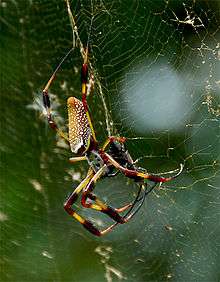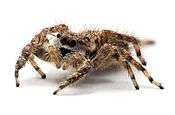Arachnology
Arachnology is the scientific study of spiders and related animals such as scorpions, pseudoscorpions, and harvestmen, collectively called arachnids. Those who study spiders and other arachnids are arachnologists. More narrowly, the study of spiders alone (order Araneae) is known as araneology.[1]

The word "arachnology" derives from Greek ἀράχνη, arachnē, "spider"; and -λογία, -logia.
Arachnology as a science
Arachnologists are primarily responsible for classifying arachnids and studying aspects of their biology. In the popular imagination, they are sometimes referred to as spider experts. Disciplines within arachnology include naming species and determining their evolutionary relationships to one another (taxonomy and systematics), studying how they interact with other members of their species and/or their environment (behavioural ecology), or how they are distributed in different regions and habitats (faunistics). Other arachnologists perform research on the anatomy or physiology of arachnids, including the venom of spiders and scorpions. Others study the impact of spiders in agricultural ecosystems and whether they can be used as biological control agents.
Arachnological societies
Arachnologists are served by a number of scientific societies, both national and international in scope. Their main roles are to encourage the exchange of ideas between researchers, to organise meetings and congresses, and in a number of cases, to publish academic journals. Some are also involved in science outreach programs, such as the European spider of the year, which raise awareness of these animals among the general public.
International
Africa
- African Arachnological Society (AFRAS) website
Asia
- Arachnological Society of Japan (ASJ) website
- Asian Society of Arachnology (ASA) website
- Indian Society of Arachnology website
- Iranian Arachnological Society (IAS) website
Australasia
Europe
- Aracnofilia – Associazione Italiana di Aracnologia website
- Arachnologia Belgica – Belgian Arachnological Society (ARABEL) website
- Arachnologische Gesellschaft (AraGes) website
- Association Francaise d'Arachnologie (AsFrA) website
- British Arachnological Society (BAS) website
- Czech Arachnological Society website
- European Society of Arachnology (ESA) website
- Grupo Ibérico de Aracnologia (Iberian Peninsula) website
- Magyar Arachnolgia – Hungarian Arachnology
North America
Arachnological journals
Scientific journals devoted to the study of arachnids include:
- Acarologia
- Acta Arachnologica – published by the Arachnological Society of Japan
- Arachnida: Rivista Aracnologica Italiana
- Arachnology – published by the British Arachnological Society
- Arachnology Letters – published by the Arachnologische Gesellschaft
- International Journal of Acarology
- Journal of Arachnology – published by the American Arachnological Society
- Revista Ibérica de Aracnología – published by the Grupo Ibérico de Aracnología
- Revue Arachnologique
- Serket
Popular arachnology
In the 1970s, arachnids – particularly tarantulas – started to become popular as exotic pets. Many tarantulas thus become more widely known by their common names such as the Mexican redknee tarantula (Brachypelma smithi).
Various societies now focus on the husbandry, care, study, and captive breeding of tarantulas, and other arachnids. They also typically produce journals or newsletters with articles and advice on these subjects.
- British Tarantula Society (BTS) website
- Deutsche Arachnologische Gesellschaft (DeArGe) website
- The American Tarantula Society (ATS) website
See also
- Cultural depictions of spiders
- Entomology
- Category:Arachnologists
External information links
| At Wikiversity, you can learn more and teach others about Arachnology at the Department of Arachnology |
